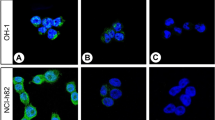Abstract
THE pharyngeal pituitary gland is a small embryological remnant constantly present in man in the submucosa of the nasopharynx1,2. In some patients it is formed of squamous or undifferentiated epithelial cells (“inactivated” type)3, in others there is adenohypophyseal differentiation (“activated” type)3 and in a few the two patterns are mixed4. The “activated” type is usually described as having abundant chromophobic cells, occasional acidophil cells and very few basophil cells1,3, but McGrath4 has reported that basophil cells can be the most conspicuous cells in some “activated” glands. It has been suggested that the pharyngeal pituitary gland is capable of playing a compensatory part in pituitary function3,5, since adenohypophyseal differentiation is said to be more prominent in the pharyngeal pituitary gland after sellar pituitary gland ablation3,5,6, but there is no evidence of hyperplasia of these pharyngeal pituitary glands7. We have now investigated the localization of human growth hormone (HGH) antigen in the pharyngeal pituitary gland with the indirect immunofluorescence (IF) technique.
This is a preview of subscription content, access via your institution
Access options
Subscribe to this journal
Receive 51 print issues and online access
$199.00 per year
only $3.90 per issue
Buy this article
- Purchase on Springer Link
- Instant access to full article PDF
Prices may be subject to local taxes which are calculated during checkout
Similar content being viewed by others
References
Haberfeld, W., Beitr. Pathol. Anat., 46, 133 (1909).
Melchioma, R. H., and Moore, R. A., Amer. J. Pathol., 14, 763 (1938).
Müller, W., Endocrine Aspects of Breast Cancer (edit. by Currie, A. R.), 106 (Livingstone, Edinburgh, 1958).
McGrath, P., Austral. NZ J. Surg., 37, 16 (1967).
Tonnis, W., Oswald, F., Müller, W., and Brilmayer, H., Klin. Wschr., 32, 912 (1954).
Van Büren, J. M., and Bergenstal, D. M., Cancer, 13, 155 (1960).
Notter, G., Acta Radiol. Scand., Suppl. 184, 103 (1959).
Beck, J. S., Ellis, S. T., Legge, J. S., Porteous, I. B., Currie, A. R., and Read, C. H., J. Pathol. Bact., 91, 531 (1966).
Ellis, S. T., Beck, J. S., and Currie, A. R., J. Pathol. Bact., 92, 179 (1966).
Hachmeister, U., Endokrinologie, 51, 145 (1967).
McGrath, P., J. Endocrinol. (in the press).
Porteous, I. B., and Beck, J. S., J. Pathol. Bact. (in the press).
Author information
Authors and Affiliations
Rights and permissions
About this article
Cite this article
MCPHIE, J., BECK, J. Growth Hormone in the Normal Human Pharyngeal Pituitary Gland. Nature 219, 625–626 (1968). https://doi.org/10.1038/219625a0
Received:
Issue Date:
DOI: https://doi.org/10.1038/219625a0
This article is cited by
-
Immunocytochemical evidence for the ability of the human pharyngeal hypophysis to respond to change in endocrine feedback
Virchows Archiv A Pathological Anatomy and Histopathology (1985)
Comments
By submitting a comment you agree to abide by our Terms and Community Guidelines. If you find something abusive or that does not comply with our terms or guidelines please flag it as inappropriate.



